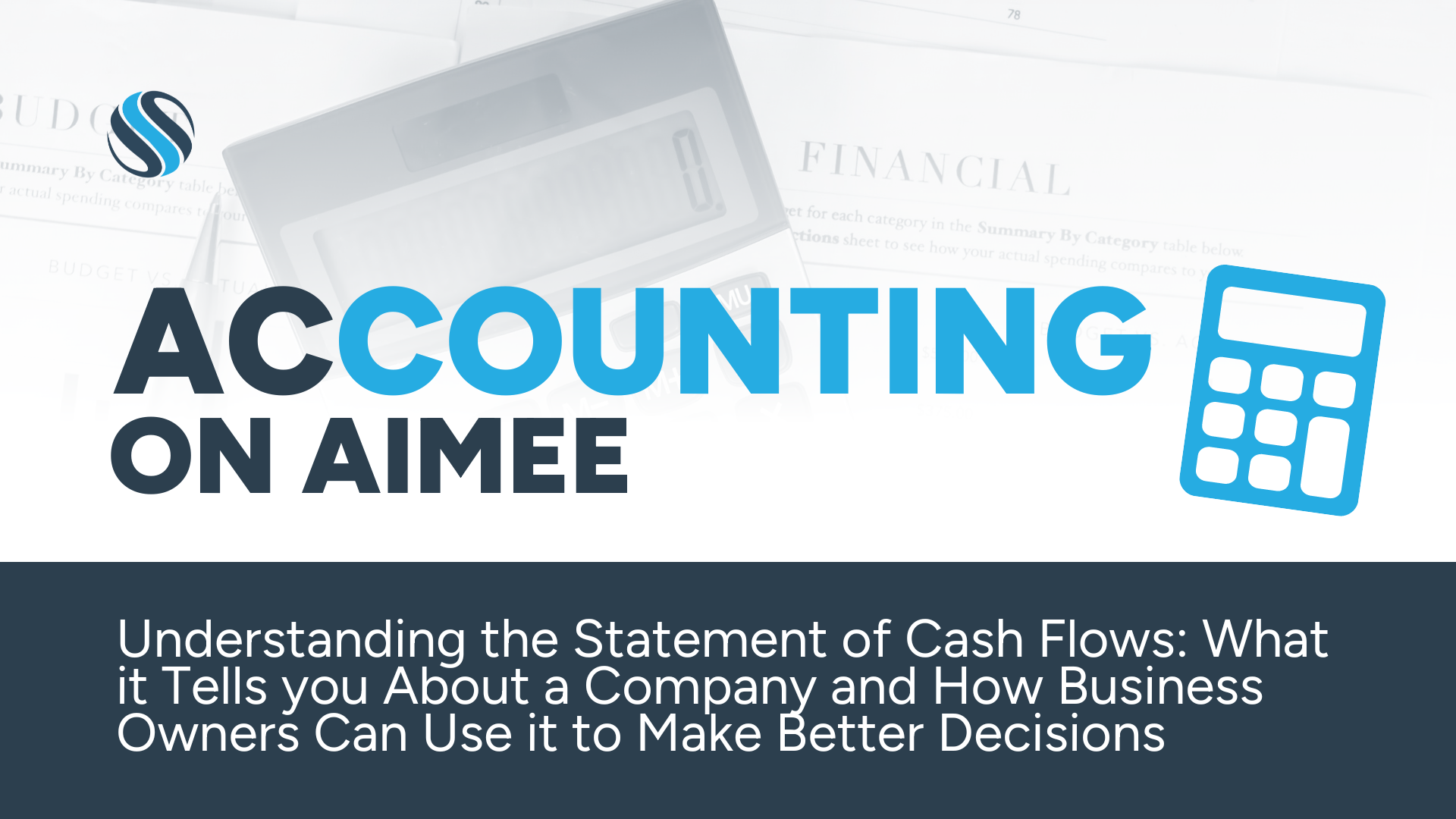
24 Sep Understanding the Statement of Cash Flows: What It Tells You About a Company and How Business Owners Can Use It to Make Better Decisions
The Statement of Cash Flows is one of the most critical financial statements a company can have, alongside the Income Statement and Balance Sheet. While the Income Statement tells you how much profit a company made and the Balance Sheet tells you the company’s financial position at a specific point in time, the Statement of Cash Flows provides insight into the company’s liquidity—its ability to generate cash to meet its obligations. For business owners, understanding and analyzing the Cash Flow Statement is essential for making informed decisions that can directly impact the company’s survival and growth.
In this article, we will break down the components of the Statement of Cash Flows, what it tells you about a business’s financial health, and how to use this information to make better strategic decisions.
What Is the Statement of Cash Flows?
The Statement of Cash Flows is a financial document that provides a detailed breakdown of a company’s cash inflows and outflows over a specific period (typically quarterly or annually). It highlights how cash is generated and spent in three main categories: operating activities, investing activities, and financing activities. This statement shows whether the company is generating enough cash from its operations to sustain itself, how it is investing for future growth, and how it is financing its operations.
The main objective of the Statement of Cash Flows is to provide a transparent picture of how much cash a business has available to meet its expenses, invest in growth opportunities, or repay debt. Unlike other financial statements that use accrual accounting—where transactions are recorded when they are earned or incurred, regardless of when the cash is received or paid—the cash flow statement highlights the actual cash inflows and outflows, showing the real-time liquidity of the business.
The Three Sections of the Statement of Cash Flows
The Statement of Cash Flows is broken down into three key sections: Operating Activities, Investing Activities, and Financing Activities. Each of these provides critical insights into different aspects of the company’s cash management, giving a clear picture of where cash is coming from and where it’s going.
- Operating Activities
This section shows how much cash the company generates or uses in its core business operations. It reflects the cash flow from day-to-day activities such as producing and selling goods or services, paying suppliers, collecting payments from customers, and covering expenses like salaries, rent, and utilities.
Key components:
- Cash inflows: Cash received from customers, interest income, and other business-related activities.
- Cash outflows: Cash spent on suppliers, employees, taxes, and interest expenses.
Operating cash flow is critical because it tells us whether the company’s core operations are bringing in enough cash to cover its day-to-day expenses. A positive cash flow from operations is a strong indicator that the company is generating cash from its primary business activities, while a negative cash flow could signal challenges in generating sufficient cash from operations.
Example: A retail business might show high sales revenue on its income statement, but if most of the sales are on credit and the company struggles to collect payments, the operating cash flow will be lower than expected. This shortfall would be evident in the cash flow statement, highlighting potential liquidity issues.
- Investing Activities
This section shows how much cash the company is spending on investments that support future growth. It includes cash used to purchase or sell long-term assets like property, equipment, and investments in other businesses.
Key components:
- Cash inflows: Cash from the sale of assets, investments, or businesses.
- Cash outflows: Cash spent on purchasing assets, making investments, or acquiring businesses.
A negative cash flow from investing activities isn’t necessarily a bad sign—it can indicate that the company is investing in its future growth by purchasing assets or expanding its operations. However, business owners need to ensure these investments will pay off in the long run.
Example: A tech company might invest heavily in research and development (R&D) or purchase expensive equipment, resulting in negative cash flow from investing activities. While this reduces short-term cash reserves, it could lead to significant innovation and growth in the future.
- Financing Activities
The Financing Activities section reflects how much cash the company is raising or repaying through external financing. This includes issuing or repurchasing stock, borrowing or repaying debt, and distributing dividends to shareholders.
Key components:
- Cash inflows: Cash received from issuing new shares or taking on new loans.
- Cash outflows: Cash spent on repaying debt, buying back stock, or paying dividends.
This section provides a view into how the company is funding its operations—whether through equity or debt—and how it’s returning value to shareholders. Heavy reliance on external financing may increase interest expenses, while companies that repurchase shares or pay dividends are often focusing on delivering value to shareholders.
Example: A company that issues bonds to raise capital for expansion will show positive cash flow from financing activities. However, the company will need to service this debt in the future, impacting on its financing activities in the upcoming periods.
Why Is the Statement of Cash Flows Important?
For business owners, the Statement of Cash Flows is crucial because cash is king. A company may appear profitable on paper (according to the income statement) but could still struggle to pay its bills if it lacks cash flow. Many business failures occur due to cash flow problems rather than a lack of profitability. The statement of cash flows gives business owners the ability to:
- Understand liquidity: It shows whether the company has enough cash on hand to meet its obligations, pay employees, and cover operational costs.
- Monitor cash flow trends: By comparing cash flow statements over time, business owners can identify trends in cash generation and spending, helping to forecast future cash flow needs.
- Make investment decisions: The cash flow statement indicates how much cash is available for new investments, such as purchasing equipment, expanding operations, or making acquisitions.
- Assess financial sustainability: It helps determine whether the company can sustain itself through operations or if it is relying on external financing.
- Evaluate financing activities: Business owners can assess how much cash is being raised from or paid to investors and creditors, providing insight into the company’s capital structure.
What Does the Statement of Cash Flows Tell You About Your Company?
The Cash Flow Statement provides a wealth of information about a company’s financial health and operational efficiency. Let’s explore some of the key insights business owners can gain from analyzing the Statement of Cash Flows:
Cash Flow Sustainability
One of the most critical aspects of the Cash Flow Statement is determining whether the company’s operations are generating sustainable cash flow. A company that consistently generates positive cash flow from operations is more likely to be financially healthy and able to grow organically.
If operating cash flow is negative, it could indicate that the company is relying on external financing to stay afloat. This could be a red flag for business owners, as it may suggest that the company’s core operations are not generating enough cash to cover its expenses.
What to Look For:
- A consistent positive operating cash flow over time indicates that the company is generating enough cash from its core operations to support itself.
- A negative operating cash flow could be a warning sign that the business is struggling to generate enough cash to cover its costs.
Ability to Reinvest in the Business
The investing section of the Cash Flow Statement reveals whether a company is investing in its long-term growth through capital expenditures, acquisitions, or other investments. For a growing company, cash outflows in this section are often seen as positive, as they indicate the business is investing in future growth.
However, if a company consistently has negative cash flow from investing activities without corresponding growth in revenue or profitability, it may indicate that the investments are not generating the expected returns.
What to Look For:
- Strategic investments in property, equipment, or technology that align with the company’s long-term goals.
- Repeated negative cash flow from investing activities could be a concern if it’s not leading to growth or if it’s depleting cash reserves.
Dependence on External Financing
The financing section of the Cash Flow Statement shows whether a company is relying heavily on debt or equity financing to sustain its operations. While borrowing money or issuing stock can be necessary for growth, excessive reliance on external financing can lead to increased interest expenses and dilution of ownership.
Business owners should carefully evaluate whether the company is sustainably using external financing or if it is accumulating too much debt.
What to Look For:
- A balance between debt and equity financing is generally preferred, as it allows the company to maintain flexibility in its capital structure.
- High levels of debt repayment without corresponding revenue growth could indicate that the company is struggling to manage its debt load.
Timing of Cash Flows
The timing of cash inflows and outflows is critical for managing a company’s liquidity. Even a profitable company can run into financial trouble if it doesn’t have enough cash on hand to meet its short-term obligations.
Business owners can use the Cash Flow Statement to identify periods of cash shortages or surpluses and adjust their strategies accordingly. For example, a company that experiences seasonal fluctuations in cash flow might need to take out short-term loans to cover expenses during slow periods.
What to Look For:
- Seasonal patterns in cash flow that require adjustments to cash management strategies.
- Mismatches between cash inflows and outflows that could lead to cash shortages or liquidity problems
In conclusion, the Statement of Cash Flows is an invaluable tool for business owners, providing a clear view of how cash moves through the company and offering insights that other financial statements may not capture. By breaking down cash flow into operating, investing, and financing activities, this statement allows us to see not only how well the business is generating cash from its core operations but also how it’s investing in its future and managing its financial structure.
For business owners, understanding these cash movements is essential for making informed decisions—whether it’s managing day-to-day expenses, planning for growth, or determining the best ways to finance the business. Keeping a close eye on cash flow helps ensure the company stays financially healthy, prepared for future opportunities, and capable of navigating challenges along the way. The more we understand the real-time liquidity of our business, the better equipped we are to drive long-term success.

























